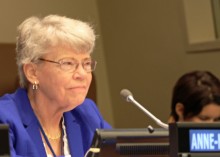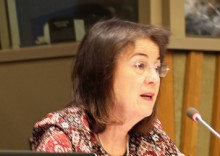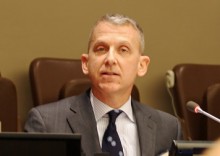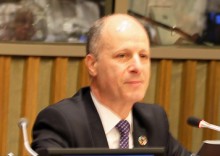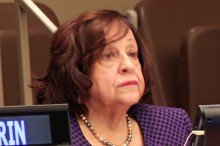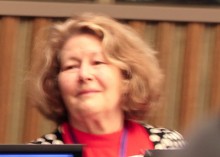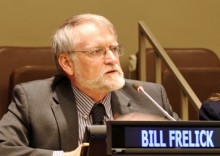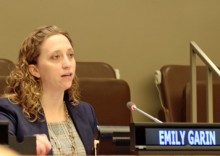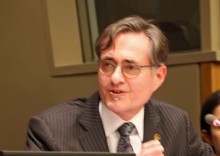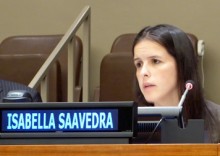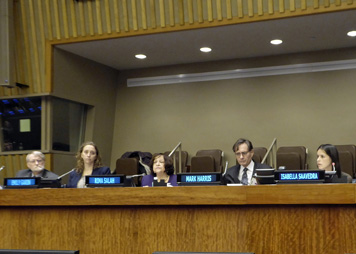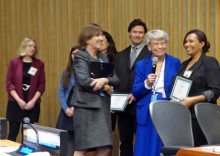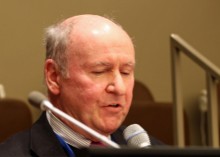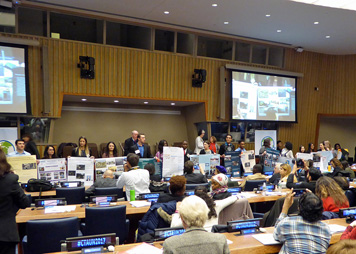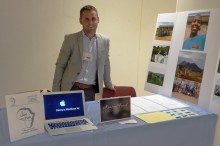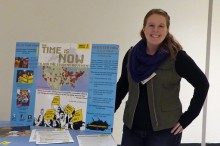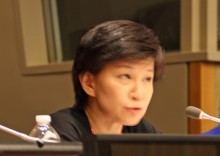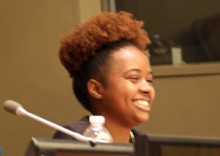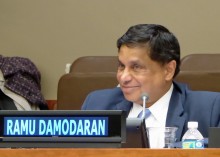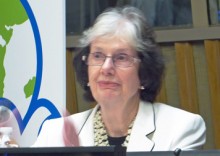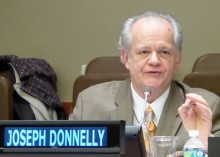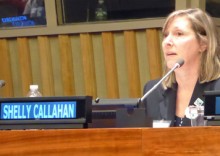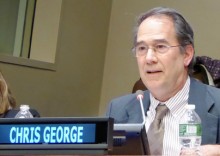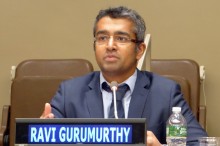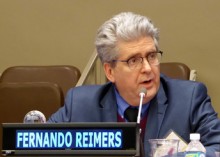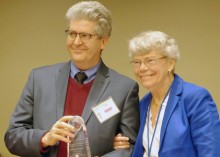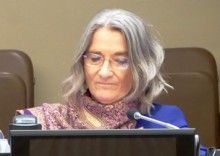2017 UN
18th Annual CTAUN Conference at UN Headquarters
27 January, 2017
REFUGEES: THE 21st CENTURY CHALLENGE 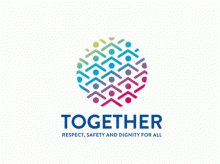
WELCOME
Anne-Marie Carlson, CTAUN chair, welcomed 704 registrants to our 18th conference. Owing to the 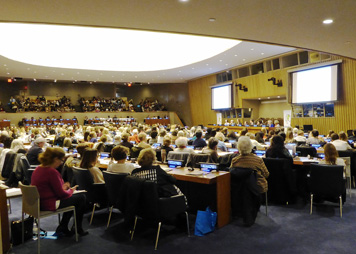 urgency of the topic, participation was one of the highest in CTAUN’s history. In addition to educators, attendees included students from Harvard, Lehigh and the University of Bridgeport, and from as far away as Keio University in Japan. Ironically, the conference was held on the day that the US President signed his temporary ban on refugee admission for a period of 120 days, and Syrian refugees indefinitely.
urgency of the topic, participation was one of the highest in CTAUN’s history. In addition to educators, attendees included students from Harvard, Lehigh and the University of Bridgeport, and from as far away as Keio University in Japan. Ironically, the conference was held on the day that the US President signed his temporary ban on refugee admission for a period of 120 days, and Syrian refugees indefinitely.
After presenting an overview of the conference schedule, Ms. Carlson introduced our opening speaker.
OPENING SESSION – CURRENT CHALLENGES
Ninette Kelley – Director of the NY office of UNHCR (the Office of the UN High Commissioner for Refugees) began by addressing the educators among us, reflecting on how arduous the task of teaching is, and thanking us for our work in preparing the next generation to solve the problems of the current one. “The role of teachers is vital,” she said.
She presented us with some harrowing statistics: Currently 65,000,000 people in the world have been forcibly ejected from their homes, 40 million of whom are internally displaced, and 25 million seeking international protection. Between 2010 and 2016 there was a 50% increase worldwide, and over half of those were children. Every day some 34,000 people are displaced.
She pointed out that ironically, the countries hosting the most refugees are also the most economically unequipped to do so. Uganda, for example, hosts the most in Africa, (30,000 from South Sudan alone – 3000 a day) welcoming them and giving them land. In Turkey there are over 2 million, in Lebanon, the size of Connecticut, 1 million, and Pakistan has been hosting Afghan refugees for 30 years.
Fewer people are able to return home. In 2015, only 201,000 were able to go back, and 107,000 were resettled. 10% of the world’s population needs resettlement; yet despite a staff of 50,000 in 128 countries, energetically providing emergency response, life-saving interventions and community support, their work is never fully funded. They receive less than half of what is needed.
In Lebanon, 88% of the population is food insecure, resulting in diminished capacity for education. Only 50%, compared with 96% of children globally, receive primary education; 22%, compared with 84%, are in secondary school, and only 1%, versus 34%, graduate from universities. How can we help?
We can help by:
- developing curriculum to teach about refugees
- expanding scholarships for refugees,
- volunteering to teach language and culture
- employing refugees, and donating to refugee organizations
- and celebrating their endurance on World Refugee Day www.unhcr.org
![]()
BACKGROUND AND HISTORY
Bob Clark – Director of Archives at the Rockefeller Archive Center in Sleepy Hollow, NY, gave us a historical survey of recent refugee activity.
The Rockefellers and the Roosevelts were great internationalists. Nelson Rockefeller, former governor of NY, persuaded his father, John D. Rockefeller, Jr., to donate $8.5 million for the land, ensuring that the UN was established in NYC, rather than Philadelphia, as originally intended. Eleanor Roosevelt chaired the committee that produced the Universal Declaration of Human Rights, protecting refugees’ rights to asylum. “The refugee crisis is not just humanitarian,” he told us. “It’s political.”
In 1943 the United Nations Relief and Rehabilitation Agency (UNRRA) was established, initially to provide assistance to countries liberated by the Allies, and began its work in North Africa. But as WWII left 30 million refugees in Western & Central Europe, it was extended to provide 25 million tons of food, plus medical care and sanitation to 17 countries, totaling $4 billion, to help stop the spread of disease and famine.
During the Cold War, UNRRA faced a tug of war with the Soviet Union, which demanded forcible replacement of what it considered its citizens, most of whom refused to be repatriated, and in 1947 the International Refugee Organization replaced UNRRA. The 1948 creation of the state of Israel caused the exodus of 700,000 refugees from what had been Palestine. In 1951 the Office of the High Commissioner for Refugees (UNHCR) was established, and its mandate extended for as long as a refugee problem exists.
European crises with which the UN has dealt include the Civil War in Greece (1946-49), the Hungarian Revolution in 1956, where 2% of the Hungarian population was resettled in West Germany and Austria, the Soviet invasion of Czechoslovakia in 1968, and 1 million Albanians exiting Serbia in 1999, after Yugoslavia was splintered through ethnic tensions released by the fall of Communism.
In Africa, the end of colonialism and the rise of independent states caused civil strife, as new nations became proxies in the Cold War between the democratic West and the Communist bloc. This was especially true in the Congo in the 1960’s and in the Angolan Civil War, causing the death of 1 million, and the displacement of 4 million more. In 1991, 1 million left Somalia, resettling in Kenya, Yemen and Ethiopia, where civil war continues to this day, and in 1994, we can add to that the genocide in Rwanda and Burundi. The forces blocking or diverting international aid have only exacerbated the misery in any of these in-country disasters.
In Latin America and Asia there were upheavals as well. In 1980, the Cuban refugee crisis brought 125,000, on rickety boats, to the US, and more than 1 million Salvadorans arrived as well. In Colombia, where armed conflict lasted for 50 years, between 2.6 and 4.3 million were displaced. The end of colonialism in India, and the resulting Hindu-Muslim Civil War brought about the creation of Pakistan and Bangladesh, causing 7million Hindus and Muslims to exchange countries, and Afghanistan, the largest generator of refugees, sent 6 million between 1979 and 2001 to Pakistan and Iran. In the 1970’s, 3 million boat people left S. Vietnam for neighboring countries. The war in Iraq in 2003 sent 4 ½ million, (16% of the country’s population) to Syria and Jordan, and the rise of the Islamic State strained resources even further. For all its efforts to step into the void, UNHCR received the Nobel Peace Prize in 1981. www.rockarch.org
 GROWING UP A REFUGEE
GROWING UP A REFUGEE
Maher Nasser – Director of the Outreach Division of the UN Dept. of Public Information – was himself a Palestinian refugee. Born in Ramallah, he spent his childhood in Kuwait, where his father worked as a teacher and was expelled in 1956 for political dissent. He had no idea, as a child, that he was a refugee, a thought echoed by many speakers later in the conference.
“What you leave behind will stay with you,“ he said. He spoke about the undying thirst of refugees for returning home, and asked us to imagine a scenario where our own homes were, at a moment’s notice, lost to us forever – with no time to retrieve much-loved possessions, photographs or anything that would keep memory alive. “Humanity is about support,” he said, and stressed the importance of education to instill this concept in children.
He went to schools sponsored by the UN, and to university on a UN scholarship. The program is no longer available, so in 2015 he began running the NY Marathon to raise money for scholarships. With a little help from CTAUN, he raised $26,000, funding the studies of three women at the University of Gaza, and two more in 2016. “Palestinians,” he said, “have the highest percentage of educated people in the world, though the unemployment rate in Gaza is one of the highest on the planet. Palestinians recognize that the best thing you can do for your children is to provide them a good education.”
He concluded by saying that the only real solution to the current refugee crisis and the prevention of future ones is political. Despite the current rhetoric, the UN must be supported. www.un.org/en/sections/department-public-information/outreach-division/
Video: “Mustafa Goes for a Walk”- about an engaging young teen living in Germany and eager to adapt to his new environment. https://www.youtube.com/watch?v=s8VhhOE1Iyw
MORNING PANEL: THE ISSUES
Rima Salah – UN Secretary-General’s Panel on Peace Operations, and Assistant Clinical Professor at the
Child Study Center, Yale School of Medicine – Moderator – (introduced by Elisabeth Shuman, Vice-Chair of CTAUN)
She began by acknowledging the images that still haunt us – of children washed up on Mediterranean shores, daily violations of human rights, violence, persecution and abduction. She pointed out the difficulties of life in and out of camps without food, medical care, and education, compounded with the struggle to adapt to local culture without the benefit of language, to laws that are foreign and to the xenophobia that deprives refugees of hope. She then introduced members of the panel:
Bill Frelick –Refugee Policy Director, Human Rights Watch. Due to the unexpected US election results in Nov. 2016, and the new realities and recent actions of the Trump administration vis-à-vis refugees, Mr. Frelich altered his original remarks.
He spoke of the role of the US as having been the leader in providing refugee protection. 40% of funds budgeted by UNHCR for refugees comes from the US and 60% of refugees have been settled in the US, more than all other countries combined. He reminded us of our tradition of moral leadership as well, and the opening of the 2016-17 session of the General Assembly with its first summit on refugees.
The result was the New York Declaration on Refugees and Migrants, condemning racism, xenophobia and violence. It also calls for a significant increase in budgets, and a fairer distribution of the costs by richer countries to support those shouldering most of the burden, 86% of which is borne by nations least equipped to do so. (In Lebanon, for example, ¼ of the population are refugees. Similarly, Jordan and Turkey are among the most overburdened.) The Declaration was followed by President Obama’s speech as the father of teen-aged daughters, abhorring the unspeakable abuse of girls worldwide, and the US commitment, pledging additional funding, and an increase from 85,000 to 110,000 in the number of refugees to be settled within the US.
“America First means Us vs. Them,” Mr. Frelich added. “President Obama has said that ‘this is a challenge to our common humanity.’ Building walls looks like a simple solution, but containment won’t resolve the problem, only engagement will. We need bridges, not walls, and the engagement of all educators and children.” www.hrw.org
Emily Garin – Policy and Data Specialist, UNICEF, and Managing Editor of the report “Uprooted: The Growing Crisis for Refugee andMigrant Children”
Ms. Garin is a strong advocate for truth in information. Most refugees (9 out of 10) relocate within their own region, either in their own or a neighboring country, due to proximity, language and cultural similarity – “a reality,” she says, “that is not reflected in the press. All official refugees start out as internally displaced persons, and half of them are children, who grow up to be refugees themselves, with the numbers continually rising. They are not the dangerous ones; they are the most vulnerable.”
Specific dangers children face are wide-ranging: family separation – 100,000 separated children are traveling alone, and subjected to detention in 100 countries, unexplained disappearance and death. They are 5 times as likely to be out of school as non-refugee migrants, and without documentation, they are unable to enroll in programs that could improve their situation.
Children need protection through legal instruments. But we also need to fight xenophobia in our communities, work to keep families together, and ensure that these 28 million children are in school and learning. We need to start thinking of them not as a statistic, but as real people, each with his or her own story, and support them, one child at a time. www.unicef.org
Mark Harris – President Emeritus, ELS Educational Services and Berlitz – Mr. Harris is a proponent of language learning worldwide as a key to assimilation and inclusion. A common language defuses xenophobia, yet language learning is not given due importance in the US, he believes. English may be our official language. But 49 million Americans, or 20% of the population, speak another language in their households. He reminded us also, that over the last 300 years, 90% of Americans were either immigrants or children of immigrants.
In Germany, any foreigner legally in the country, even pending a request for asylum, can attend a language and integration program. Anyone who cannot pay the nominal fee of €1.95 can petition to have it waived. The rest is entirely paid for by the government. The curriculum and teacher qualifications are strictly controlled, and the program consists of 700 lessons – enough to achieve the level of competency in German required for receiving social benefits.
Though children learn quickly when exposed to local languages, learning in the camps is difficult, as many of the teachers are not fluent beyond their own native tongue. He showed us a slide of the top 6 hosting countries and the languages they speak. In only two of the six, Lebanon and Jordan, is Arabic the native language. In Turkey, which hosts 2.5 million refugees, the official language is Turkish; in Pakistan, which hosts 1.6 million, the languages are Urdu and English. Iranians speak Farsi, and Ethiopians, Amharic. If language issues are not addressed, it will create a communications problem of a magnitude the world has never seen.
Without language, there is no ability to get an education, especially at the university level, despite the availability of scholarships. Language is also a prerequisite for finding a job. He reminded us of the myth that all refugees are uneducated. In fact, many come highly educated, having held professional careers in their own countries. And refugees want to work.
He spoke about the International Institute of Education (IIE), which has a policy of accepting applications of imperiled people, depending upon their area of study. He ended by saying, “Language stimulates our brains, and touches and warms our hearts. Somewhere between our brains and our hearts is where HOPE can be found.“ www.els.edu/en/Sitemap
Isabella Saavedra – is an attorney for the Catholic Legal Immigration Network, (CLINIC) and Staff attorney for Catholic Charities, working with undocumented immigrants who are facing the complexity of the US Immigration System.
She arrived in the US at the age of 10 when her family fled from Colombia, and lived undocumented for 10 years. Following law school, with a passion to become an immigration attorney, she went to work pro bono for 4 months at the largest detention center along the Texas –Mexican border. “Detention,” she said, “is like jail.” She also compared it to an internment camp.
In 2014, there was a surge of children leaving Central America. Captured by the border patrol, they were placed in mandatory detention, with no right to legal counsel or protection against ‘expedited removal’ (deportation). Before being placed in detention, they were held in “ice boxes” – holding cells at cold temperatures. At this time of year, it was typically 107 degrees in Texas, resulting in fevers and chills. They were told there was no medicine, and given water tinged with arsenic. When these children expressed a fear for their lives if they returned to their home countries, they could be held for anywhere from 2 weeks to 9 months, until an asylum officer became available.
At the Dilley detention facility, (euphemistically named the Southern Texas Family Residential Center) only an hour from San Antonio, yet well hidden, she prepared women and children for their asylum interviews. There were 2,400 people detained at Dilley. She and her colleagues from 4 pro bono organizations in the CARA PROJECT– social workers, paralegals and other attorneys – saw victims of rape and violence from El Salvador, Honduras and Mexico. They worked 6 days a week, 15 hours a day. “Mothers and children had to ask for help,” she told us. ”We couldn’t solicit them. Many never even knew we existed.”
The Cara Project accepts volunteers. She encouraged all of us to look into the Project to witness how asylum seekers are treated in our own backyard, and urged us to pressure our Congressional leaders to end family detention. Privatized centers are earning huge profits, so there is currently no incentive for bringing family detention to an end. www.cliniclegal.org
A Q&A session followed. Audience participants asked about curricula for teaching ESL. Panelists were unable to provide suggestions; even the International Rescue Committee has no set program. Volunteers create most curriculum materials in public schools and churches, although programs like Rosetta Stone are available for purchase, and online classes like Duo Lingo, intended for individuals, can be adapted. In Canada, though, like Germany, the government funds ESL learning and ESL curricula – they even include temperature guidelines for the room, which should not rise above 79 degrees Fahrenheit!
A second question was asked about ICE – (Immigration and Customs Enforcement). Among the Trump administration’s executive draft orders, one would deputize local police to drastically expand the removal of refugees found anywhere along the US border with Mexico. Another would cut funding to agencies by 40%, which would have a Draconian impact on refugee protection. Funding to UNRWA (the UN Relief & Works Agency), which supports Palestinian refugees, could be cut altogether.
Video: “John Cho Tells the Story of a Syrian Teacher” – about the experience of teaching in a camp, without access to supplies, and his pride in a gifted mathematical student. https://www.youtube.com/watch?v=hsRycKSfLxc
 EXCELLENCE IN EDUCATION AWARD – (formerly Best Practices) – Eileen Venezia, Chair; Awards presented by Anne-Marie Carlson
EXCELLENCE IN EDUCATION AWARD – (formerly Best Practices) – Eileen Venezia, Chair; Awards presented by Anne-Marie Carlson
Recipients: Dr. James Badger, Beth White and Hattie Burchardt – International Community School, Atlanta, GA Submission: Successfully Creating a Diverse Community of Refugee, Immigrant and Local Children Learning Together Haime Haile – Georgia State University with the Clarkston Community Project Submission: Voices of Hope – Fostering a Welcoming Environment for Refugees and Immigrants Sarah Beltz and Heather Elvidge and 7th Grade Educators – Keith Valley Middle School, Horsham, PA Submission: Wishing for Wells: Water for South Sudan. Inspired by the reading of A Long Walk to Water by Linda Sue Park For more information on the projects, see the Awards section on our website.
POSTER AWARDS winners introduced by Dr. Thomas Ward, University of Bridgeport
Entries represented a broad range of countries, including 18 fromBalasore College in India through the intervention of CTAUN member Professor Basanti Chakraborty, and others representing Nigeria, and countries in the Middle East,
Asia and Europe. There were 20 contest winners, presenting outstanding artwork related to refugee issues, on such topics as “Across the Border: What Happens to Refugees After They Leave?” “Child Refugees,” “The Alien Registration Act,” and “Vulnerable Yet Resilient: The Gender Issues of Refugees.”
POSTER CONTEST WINNERS:
Aishwarya Anand, Alexandra Tarzikhan, Alok Pillai, Ama Kouassi, Chloe Jen, Christopher Santos, Christopher Warren, Emily Siniscalco, Gabrielle Jacob, Jack Kinst, Kaitlin McDermott, Malak Akinlabi, Kristin Marcinek, Martina Santia, Nichole Sorge, Oluwatosin Akegbejo Samsons, Robert Bender, Shubban Gohil, and Swechhya Bhattarai.
Images of the winning posters can be viewed at https://drive.google.com/drive/folders/0B81GYKIuqaEkWFZaSHlzYS1pZTA?usp=sharing
LUNCH AND INFO FAIR –
Info Fair Exhibitors included:
- Amnesty International: www.aiusa.org
- Church World Service: www.cwsglobal.org
- Concern Worldwide: www.concernusa.org
- The FDR Presidential Library and Museum: www.fdrlibrary.marist.edu
- Integrated Refugee and Immigrant Services: www.IRISCT.org
- Kamran Farid Foundation: www.kamranfaridfoundation.org
- Mohawk Valley Resource Center for Refugees: www.mvrcr.org
- UNA-USA: www.unausa.org
- U.N. Department of Public Information: www.un.org
- U.N. Sustainable Development Goals Action Campaign: sdgactioncampaign.org
- U.N. High Commissioner for Refugees: www.unhcr.org
- U.N. Population Fund: www.unfpa.org
- U.N. Women: www.unwomen.org
- Working with Immigrant and Refugee Populations:
- World Food Program: www.wfp.org
- World Health Organization: www.who.int
AFTERNOON KEYNOTE: THE CURRENT UN ROLE AND ACTIONS
Izumi Nakamitsu – UN Asst. Secretary-General, and Asst. Administrator of the United Nations Development Programme (UNDP) Ms. Nakamitsu brought greetings from our new Secretary–General, Antonio Guterrez, from Portugal, and began by commending CTAUN for organizing this event, and for shining a light on one of our most pressing issues: human displacement.
She spoke about the broader dimensions of actions the UN is taking to address the issue. In September of 2016, the General Assembly held its first summit on refugees, attended by several heads of state, including President Obama. The summit produced an agreement that firmly recognizes the UN as the best platform for improving the lives of refugees. This resulted in the aforementioned New York Declaration, in which member states implemented a framework focusing on strengthening the social contract between host nations and refugees, collecting lessons learned, and providing a repository of best practices and outreach tools that can be applied in local contexts. She introduced this new global partnership, called “Together,” through a video featuring the Secretary–General. The program, unanimously accepted by all 193 member states, will run through 2018, when they will gather to assess their work and adopt two Global Compacts on Refugees.
She sees migration as ‘a growth potential’ and seeks to change negative perceptions. “We are all products of human mobility,” she said. The issue of smuggling and trafficking of migrants needs to be addressed. So does xenophobia. “It is by acting together that we will turn fear into trust.” She urged us to share experiences with one another, and to dispel the idea that migrants hold back the country toward which they migrate. “Teachers have the greatest responsibility to change minds,” she said, reminding us that young people are powerful agents of change. “The UN wants to work with civil society. We want to hear from you.” www.undp.org
SPOTLIGHT
Bahati Ernestine Hategekimana – 2016 winner of the “Many Languages, One World” essay contest for the Global Youth Forum, sponsored jointly by the UN Academic Impact (UNAI), the UN Dept. of Public Information (DPI) and ESL Educational Services – introduced by Mark Harris. We saw a power point presentation as she told her story.
Bahati is a refugee from Rwanda, who, like Maher Nasser, never realized as a child that she was a refugee. At the age of 2 months, she fled with her family to the Democratic Republic of Congo (DRC), and was forced to flee again 2 years later, when the Rwandan situation expanded into the DRC, the refugee camp was razed and people slaughtered by the militia. (She read us, in Swahili, the death threat she and her sister received.) With migrants from Burundi and Somalia, she relocated to Kenya, where they were given land through the Catholic Church, and built a school. Her father then tutored her in English, enabling her to get a scholarship to Moi University, where she is now in her third year as a nursing student.
“When I grow up, I want to save lives. I don’t want to be helpless when people are dying around me, “ she explained. In her school, only 15% of students were girls. ‘The system is obstructing the possibility of jobs for refugees,” she said. “It’s expensive, and we are taken advantage of.” She urged us to advocate for right to work laws in host countries.
“We need to understand that these are people who need compassion above all else. They did not choose their situation, just as you did not choose your parents or the country you were born in. You could have been born in Rwanda. I could have been born in Syria. Just because it did not happen so, is no reason to turn a blind eye to their suffering.”
YOUNG REFUGEE VOICES – moderated by Ramu Damodaran, Director, United Nations Academic Impact (UNAI)
www.un.org/en/sections/department-public-information/outreach-division
Hearing the moving personal stories of these 5 young people originally from Iraq, Syria, Burundi and Sudan was a highlight of the day. They expressed profound gratitude for the assistance they had received and all of them stressed the importance of education in changing lives. Video: “What They Took With Them” (see resources)
AFTERNOON PANEL – ASSISTANCE AND RESOURCES (introduced by CTAUN Vice-Chair, Grace Murphy)
MODERATOR: Joseph Cornelius Donnelly, Permanent Delegate to the UN, from Caritas Internationalis, a Catholic organization working on behalf of the poor in 200 countries and territories, supporting all people based on need, not creed. Caritas has supported more than 250,000 displaced victims since the fall of Mosul in 2014. Mr. Donnelly is also Chair of the NGO Working Group on the Security Council, and has called on NGOs worldwide to end hunger by 2025. www.caritas.org
He began by commending CTAUN and speaking about the courage and activism of Dag Hammarskjold, whom he called ‘ the most beloved UN Secretary–General,’ and urged us to leave our own ‘markings’ on every person we meet. He advocates passionately for social justice for refugees, asking, “What will you do to help them call something home?” He believes that making a difference – financially, academically, socially and communally – lies with “We the people, not the government.” It’s what education is all about. He held up a copy of the day’s NY Times, which had, on the front page, a photo showing a huge shadowy fence in McAllen, Texas, on the Rio Grande Valley border with Mexico, where he visited and met refugees two years ago. His “It’s a jail,” he said.
Shelly Callahan – Executive Director, Mohawk Valley Resource Center for Refugees, Utica, NY Utica was the subject of a 2006 story, “The Town That Loved Refugees.” The story is inspirational, and Utica a role model for other communities. Towards the end of the 20th Century, it had fallen on hard times and become a ‘rust belt city,’ with properties being burned down to avoid taxes, and the population diminishing to a trickle. When the numbers dip below 50,000, federal funding changes. There was a sense of doom and gloom, and even a sign that read, “Will the last person out of Utica please turn off the lights?”
In 1981, one woman opened a refugee center, which now welcomes 450 refugees a year and over the past 36 years has assisted 16,000 – primarily from Bosnia (5000), but many from countries in the Middle East and Africa. These refugees, seeing safety and opportunity, willingly took small jobs and rebuilt the city. In doing so, they also built a sense of community, brought economic development and attracted many new businesses, bringing the population up to 63,000. 1 in 5 is foreign-born, enriching the town with its diversity. Refugee students are motivated, and do well in school. In return, the local community values them.
Ms. Callahan was very firm in stating that it is not true that refugees take jobs from Americans. She believes that the current US administration is threatening our way of life and core values. “Immigrants and refugees have always been a source of good for the United States,” she said. www.mvrcr.org
Chris George – Executive Director, Integrated Refugee and Immigrant services (IRIS), New Haven, CT After serving in the Peace Corps “ the toughest job you’ll ever love,” he spent 13 years working in refugee camps, and remembers everywhere, their ‘radical hospitality’ and kindness in sharing what little they had.
He gave us a valuable look at the 18 months – 2-year vetting process, through the eyes of a young family. Vetting starts with the State Dept. looking at a list, given them by UNHCR, of the most vulnerable in the camp. A preliminary interview asks personal questions about their home life and reasons for wanting to leave, family left behind etc. This is followed by a second interview, with Homeland Security, which is more of an interrogation, including finger printing and the like. After 6 months, there is a 3rd interview, to verify the accuracy of what was said earlier. This information is then shared with the CIA, FBI, the military etc. After another 6 months, during which the intelligence community verifies the veracity of the interview responses, the applicants for asylum are given medical examinations for both mental and physical health. At any stage, if there is the slightest cause for doubt, they are removed from consideration.
If they pass the tests, they are then asked if they have relatives in the states, who might be responsible for their transportation, greeting on arrival and resettlement. If not, they are arbitrarily assigned to a location, and asked to sign a promissory note for a loan to cover their airfare, which they must begin to repay after 6 months. US government requirements specify that they be given a culturally appropriate hot meal two hours before arrival, be welcomed at the airport and introduced to a case manager. This person helps establish them in an apartment equipped to meet their immediate needs, enroll children in school, and find a job. Community groups have shown considerable interest in getting in on the action – there have been 50 since the summer of 2015. “To know a refugee is to support resettlement programs,” Mr. George said. www.irisct.org/index.php/community-co-sponsorship
Ravi Gurumurthy – Chief Innovation Officer at the International Rescue Committee (IRC) and founder of its Innovation Center.
The IRC has 12,000 staff working in 30 countries, and has resettled 10,000 refugees in the US. However, there is a need for innovation, as the nature of the problem is changing. Access to data is more challenging due to the destruction caused by ISIS, and refugees spend longer periods of time in urban centers. “There is a need to be self-critical about what works in generating large-scale jobs, and how literacy programs can become more efficient.”
He pointed to the danger of fatalism. There are solutions if we invest in research. Life chances depend on early childhood. What skills do children need when they’re on the move? What impact does toxic stress have on their ability to learn? The IRC has developed a partnership with Sesame Street to create multi-cultural programs for young children to help diffuse the stress and inculcate skills for resilience.
He talked about efforts in Jordan to remove barriers to jobs for Syrian refugees, by giving incentives to companies who hire them, as well as promoting growth in the European market, and trying to make the language of response more humanitarian than bureaucratic. www.rescue.org Responding to questions “What can we do?” the reply was: Evidence suggests that cash transfers work better than donations of clothing, blankets or other items. There are 350 refugee agencies around the country. We were urged to:
- engage with the people, making them feel secure
- ask representatives from these agencies to speak at local community functions
- take a refugee on a field trip
- publicize volunteer programs
- take political and public action
CLOSING ADDRESS
Fernando Reimers – Ford Foundation Professor and Director, Global Education Initiative, Harvard Graduate School of Education Prior to his presentation, Dr. Reimers was given CTAUN’s first Global Citizen Award, an exquisite crystal globe, in memory of Barbara Walker, one of the founders of CTAUN, and an outstanding global citizen herself. Narin Stassis, Chair of the selection committee, made the presentation.
After thanking CTAUN for the award, he began with a quote from ancient Rome. “I am human, and nothing that is human is alien to me,” – Publius Terentius, and walked us through some of the highlights of human evolution. He spoke of a 15th Century Franciscan priest who chastised a congregation in what is now the Dominican Republic for their treatment of indigenous people. “Have you no soul?”
It was a refugee, a Moravian minister named John Comenius, who had settled in Amsterdam 400 years ago, who was the intellectual father of the concept of institutional education that led to the Enlightenment in France. With Rousseau came the notion that individuals could improve themselves through education and democracy – ideas that were reflected in the Declaration of Independence and the US Constitution. From these evolved the concept of a public school, to make people more cosmopolitan.
Yet from 1870 to the signing of the Declaration of Human Rights, education was primarily for the elite, and the vast majority couldn’t set foot in a school. After World War II and the Holocaust, when we began asking ourselves, “How did we allow this devastation to happen without doing anything?” the UN, through the leadership of Eleanor Roosevelt, produced the 30 articles of the Declaration.
“To become human is to become a global citizen,” Dr. Reimers said. He showed a slide of the Norman Rockwell painting “Do Unto Others” displayed in the UN, and talked about the split between countries that see themselves as global citizens and those that do not, and those in the US who believe in tolerance and respect for others (70%) and those who do not (30%). “Yet that 30% is capable of hijacking democracy,” he added. It took Nazi Germany only 10% to sabotage democratic institutions in that country, and in the US only 5% believe that they can fully trust someone of another religion. Ironically, globalization seems to make people less kind and more self-focused. Ten years ago, concern for one another was much higher. We should worry about that.
Hate crimes are on the rise in schools and neighborhoods. He spoke about the Southern Poverty Law Center which counts hate crimes, pointing to some 900 hate groups operating in the US, and close to 1,000 incidents among the educated as well as the uneducated, since the election of President Trump. “When people deny others their humanity, they can do anything to them individually or to the group they represent. That’s what led to the gas chambers.”
The environment should also be a cause for concern. He told us that 13 of the 14 candidates for the US presidency in 2016 believe that climate change is a hoax.
Global citizenship is about critical thinking. Quoting Theodore Parker, a 19th Century American Transcendentalist, Martin Luther King once said, “The arc of the moral universe is long, but it bends toward justice.”
“But not on its own,” Dr. Reimers added. “People credit your patriotism when you have a global mindset.” He suggested his book The World Course: Empowering Global Citizens, available free on Amazon Prime, as a basis for creating curricula that takes the long view. Learning about and acting on the UN’s 17 Sustainable Development Goals (SDGs) is also critical.
He ended by reading an excerpt from the poem “Home” –
“No one leaves home unless home is the mouth of a shark No one puts children in a boat unless the boat is safer than the land….” www.gse.harvard.edu/faculty/fernando-reimers
![]() The conference ended with an Outcome Statement, read by Kathryn DeLawter, Chair of CTAUN’s Advisory Council. The statement was produced by Cora Weiss of The Hague Appeal for Peace, and Anne-Marie Carlson, Chair, CTAUN:
The conference ended with an Outcome Statement, read by Kathryn DeLawter, Chair of CTAUN’s Advisory Council. The statement was produced by Cora Weiss of The Hague Appeal for Peace, and Anne-Marie Carlson, Chair, CTAUN:
Statement adopted by acclamation at the end of the 18th Annual CTAUN Conference at the UN: Refugees: The 21st Century Challenge Conference – 27 January 2017
As refugees continue to risk their lives to escape persecution, violence and war, there is a shared responsibility within the international community to protect their lives and address the causes of this major 21st century challenge. Figures compiled by the United Nations High Commissioner of Refugees reveal that more than 21 million fellow human beings around the world have become refugees. Over half of these individuals are under the age of 18. In recognition of the New York Declaration adopted at the UN Summit for Refugees and Migrants on 19 September 2016, this Refugees:The 21st Century Challenge conference calls upon the entire international community – governments, non-governmental organizations and civil society in general – to help:
● protect the rights of all refugees, including the rights of women and girls, and promote their participation in finding solutions
● ensure that all children receive education within a few months of arrival
● respond to and help prevent sexual and gender-based violence
● support those countries which are rescuing, receiving and hosting large numbers of refugees and migrants
● work toward ending the practice of detaining children for the purpose of determining their refugee status
● and to ensure that refugees are not returned to situations where their lives and freedom are at risk Special efforts must also be made to stop the causes of refugee flow. Preventing war, terrorism, persecution and other causes should include aid for economic development, education and a commitment to human rights.
Contact: Anne-Marie Carlson, Chair Committee on Teaching About the United Nations (CTAUN) chair@teachun.org
Thank you to the following rapporteurs who contributed to this report: Elizabeth Estes, Peter Brosnan, Rachel Min, Andrea Hassler, Ayobami Ashaolu, Sally Na, Emily Houwin and Allison Love, and to Peggy Montgomery for her critical insights. Antonia Giangrande – editor
Among the record number of participants attending the Conference were eighth-graders from the Brown School in Schenectady, NY – see article in The Daily Gazette; We also welcomed students from Somerset County Vocational Technical School, NJ with their teacher Guillermo Reina who shared their impressions of the conference
Congratulations to the winners of the
CTAUN EXCELLENCE IN EDUCATION AWARD, CTAUN POSTER CONTEST and to Professor FERNANDO REIMERS, Harvard Graduate School of Education – our first recipient of the CTAUN GLOBAL CITIZENSHIP AWARD IN MEMORY OF BARBARA WALKER
Read the Huffington Post Article by Prof. Reimers following the Conference, as well as the PassBlue article by Irwin Arieff
Check out TEACHER RESOURCES

